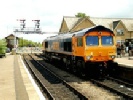17th October 2009
© By Stuart Smith
From Williton station, the bus took us first to Washford WSMR (West Somerset Mineral Railway) station, where we viewed a bungalow that has been built on the site on the former station. Traces of the track-bed can still be found in places. Continuing through Torre, we reached the village of Roadwater where the station is now a private residence hidden away behind several other properties. Although we were only using a small coach (the same as in the Lynton & Barnstaple trip) the roads were still a bit of squeeze in some places and we had a tight manoeuvre to reach the old level crossing where the two original gates are still located. However, they took quite a bit of finding as they are totally covered and hidden by ivy. The track-bed from here is now part of a tarmac road, although there is little trace of it once it turns into a rough track way beyond. This leads all the way to the old Combe Row station, although this part was not explored on this occasion, which was a shame as it was situated at the foot of the mile 1 in 4 Brendon Hill incline.
From here we continued along some very narrow country lanes to Luxborough Road station. It was described as "utterly derelict" in 1911, and 99 years on very little has altered - although the remains still stand today. The station at Gupworthy was not visited, although we were told that it is still inhabited and much unchanged from its heyday. A visit was made to the Langham Hill Iron Mine where conservation work has been undertaken on the pithead, which includes a short section of track along the WSMR formation. Next it was on to the Brendon Hill Incline, where from the top, the restoration of the Engine House structure was viewed. This substantial structure alone is worth seeing, if you havent time the whole itinerary. The actual incline itself has recently been transformed into a footpath, and across the road is the never-opened Brendon Hill passenger station, which survives completely. As it stands on private property, permission to view it must be sought first. The next call was to Watchet Harbour where the station and goods shed can still be found. On the harbour itself, a short section of original WSMR track has been uncovered after years of being covered over with concrete, and is currently being restored as a harbour-side feature. This will be completed sometime during 2010 it is hoped. From Watchet we made our final road journey to Minehead, were we transferred back to Bishops Lydeard on the last service train of the day.
Our final 'link to the past' from the WSMR was seen at Kentsford occupied crossing (around half a mile west of Watchet station) where the GWR and WSMR had a one-day temporary connection laid in 1907, and possibly again in 1911, for locomotive transfer purposes. Apart from this short section of temporary track, the West Somerset Mineral Railway was totally isolated from the rest of the railway network.



